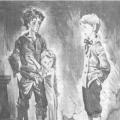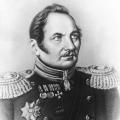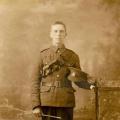The snow melts and streams run. Outline of a lesson on speech development (junior group) on the topic: Reading poem A
Preview:
Reading of A. Pleshcheev’s poem “Spring”.
Didactic exercise“When does this happen?”
Target: Introduce children to A. Pleshcheev’s poem “Spring”. Learn to name the signs of the seasons.
Part 1.
Educator:
Guys, please tell me what time of year it is now?
Children:
Spring!
Educator:
That's right, guys. The sun is shining brighter, the snow has melted, streams are flowing, migratory birds have returned from “warm countries”.
The wonderful Russian poet Alexei Nikolaevich Pleshcheev wrote about the arrival of spring like this:
Spring.
The snow is already melting, the streams are flowing,
There was a breath of spring through the window...
The nightingales will soon whistle,
And the forest will be dressed in leaves!
Clean sky blue,
The sun became warmer and brighter,
It's time for evil blizzards and storms
It's gone for a long time again.
Educator:
Did you like this poem? Listen again to how beautifully the author describes the arrival of spring (re-reading the poem).
Educator: Guys, let’s remember how Alexey Nikolaevich Pleshcheev wrote about autumn:
Autumn.
Autumn has come
The flowers have dried up,
And they look sad
Bare bushes.
Withers and turns yellow
Grass in the meadows
It's just turning green
Winter in the fields.
Part 2.
On the tables in front of the children there is a cardboard flower (symbol of spring) and a yellow maple leaf (symbol of autumn).
Educator:
Guys, let's play? There is a flower and a leaf in front of you. I will name the signs of spring or autumn, and you, if I named the sign of spring, show me a flower, and if of autumn, show me a leaf.
The grass is turning green, the sun is shining... (spring)
It became colder, the flowers dried up... (autumn)
The snow is already melting, streams are flowing... (spring)
The grass in the meadows withers and turns yellow... (autumn)
Birds flew to us from “warm countries”... (spring)
Educator:
What a great fellow you are! We got a beautiful spring meadow of flowers and bright autumn leaves!
Part 3.
Outdoor game "Birdhouses".
Educator:
Guys, one of the first to fly to us from “warm countries” with the arrival of spring is starlings. And people make birdhouses for them (show a starling and a birdhouse in the picture).
We guys have been staying too long with you! Let's play a little more. Everyone come out here to me (to the play area).
Progress of the game.
In the play area there are pre-prepared chairs with pictures of birdhouses glued to them (one less than for children).
Educator:
You guys will be starling birds, and these little chairs of yours will be birdhouses.
You run, flap your wings and sing the song “Chiv-chiv-chiv...”. When I tell you “Go home!”, you run to the chairs and sit on them. Some of the children are left without a birdhouse.
The game is played three times.
After finishing the game, the teacher puts up another chair, so there is an equal number of chairs and children.
Educator:
What good starlings you made. Take your seats.
Bottom line.
Educator:
Guys, today we got acquainted with the poem by A.N. Pleshcheev “Spring” and remembered the poem by A.N. Pleshcheev "Autumn". We learned to distinguish the signs of spring from the signs of autumn and played interesting game. Did you enjoy the lesson today?
You guys are great! Nice job! Clap your hands!
On the topic: methodological developments, presentations and notes
This lesson summary allows children to memorize text using mnemonic tables (pictures)...
READING OF A. PLESHCHEYEV’S POEM “SPRING”. SINGING
: introduce a new poem; learn to name the signs of spring, sing emotionally, expressively, independently; develop a poetic and musical ear; develop an interest in art...
“Spring” Alexey Pleshcheev
The snow is already melting, the streams are flowing,
There was a breath of spring through the window...
The nightingales will soon whistle,
And the forest will be dressed in leaves!Pure heavenly azure,
The sun became warmer and brighter,
It's time for evil blizzards and storms
It's gone for a long time again.And my heart is so strong in my chest
He knocks as if he's waiting for something
As if happiness is ahead
And winter took away your worries!All faces look cheerful.
“Spring!” - you read in every glance;
And he, like a holiday, is happy about her,
Whose life is only toil and sorrow.But the playful children have loud laughter
And carefree birds singing
They tell me who is the most
Nature loves renewal!
Analysis of Pleshcheev’s poem “Spring”
The image of spring in Russian literature is closely connected with the renewal of nature and its amazing transformation. This topic worried many poets, who never ceased to be amazed at how wisely our world is structured, and how many joyful discoveries it can give to those who know how to see and feel beauty. Poetry, dedicated to the first sun rays, melting snow and lush young grass, many poets have. However, the most famous of them is rightfully considered to be the work of Alexei Pleshcheev “Spring”, written in 1872.
In the first stanza of this poem, one can feel subtle, but irreversible changes in nature. The compacted and blackened snow turns into cheerful streams, and the author expresses the hope that “the nightingales will soon whistle and the forest will be covered with leaves.” The poet associates clear blue skies and bright sun not only with the coming spring, but also indicate that “the time of evil blizzards and storms has long passed again.” And this evokes a feeling of genuine happiness in the author’s soul, his heart beats harder “as if waiting for something.” Along with winter, according to Pleshcheev, worries and sorrows go away. Even though there is a rather difficult period ahead field work, “all the faces look cheerful.” After all, spring brings with it not only new sensations, but also hopes for the best for those “whose life is only hard work and grief.” By such people, Pleshcheev means peasants to whom spring gives the opportunity to lay the foundations of personal well-being and provide themselves with a good harvest. That is why people are looking forward to the start of the sowing season with impatience and joy.
Contrasting gloomy winter and warm spring, Pleshcheev notes that life according to the laws of nature is natural and reasonable. Therefore, you should not neglect them, so as not to deprive yourself of the opportunity to be in harmony with the world around you. It is this harmony that, according to the author’s observations, is felt especially acutely by children and birds, who react with delight to how everything around them is transformed, and this feeling of novelty gives strength to live, dream, believe and strive for the best.
Each line of the poem “Spring” is filled with warmth, sincere happiness and peace. Alexey Pleshcheev masterfully managed to convey these sensations and create a holistic picture of a transforming world, in which every little thing is important, be it “the singing of carefree birds” or “the ringing laughter of playful children.” And it is these details that many of us are interested in everyday life do not pay attention, they give the opportunity to fully experience how attractive life can be if you are able to appreciate what it gives to each person.
Analysis of Pleshcheev's poem Spring 5th grade according to plan
Plan
1. History of creation
2.Genre
3. Main theme
4.Composition
5.Size of the piece
7. Main idea
1. History of creation. The work “Spring” was written by Pleshcheev in 1872. Many Russian poets addressed the theme of the spring awakening of nature. The poem in question belongs to the most successful works dedicated to spring.
2. The genre of the work is a lyric poem.
3. The main theme is the spring renewal of nature and the feelings that it awakens in every person. The author is infinitely glad that the evil and cold winter has passed. Nature comes to life under the rays of the spring sun. Together with nature, the soul is cleansed of worries, new hopes and dreams awaken in it. An important point The poem is a mention of people “whose life is only toil and sorrow.” The author does not forget about ordinary peasants. He believes that their difficult situation is also brightened by the onset of spring. The main heralds of spring are birds and children. Their “ringing laughter” and “singing” are a solemn hymn dedicated to the next fabulous transformation of nature.
4. Composition. The poem is divided into three parts. It opens with an image of a woman coming to life spring nature. In the second part, the author describes the human feelings that arise at this time. In the finale there is a fusion of human and natural triumph.
5. The meter of the work is iambic tetrameter.
6. Expressive means. The author applies bright epithets(“brighter”, “playful”, “ringing”), which create a feeling of celebration. Describing natural phenomena, Pleshcheev uses personification (“the forest will dress”, “streams will flow”). The contrast between the “evil snowstorms” and the “bright sun” greatly enhances the impression.
7. The main idea of the work is the inevitable onset of happiness. Pleshcheev shows that the arrival of spring can revive not only nature, but also the human soul, which will forget all its sorrows and sorrows.
Hello guys
Who can tell me what section we started studying in the last classes?
Right. Today we continue to talk about spring, about natural phenomena associated with the onset of this time of year and will get acquainted with the poem “Spring” by A. N. Pleshcheev.
Pleshcheev Alexey Nikolaevich (1825-1893) - poet, prose writer, playwright and literary critic. The poet's childhood passed in Nizhny Novgorod. His mother, Elena Alexandrovna, was involved in raising her, and she managed to give her son good education. Alexey Nikolaevich wrote quite a lot of works not only for children, but also for adults)
I will now read you a poem by this poet - “Spring”. Think about what sounds you heard when listening to this poem (reading by heart)
What is this poem about?
What sounds did you hear?
Well done, how attentive you are!
Think about who is lyrical hero this poem?
What helps reveal the image of spring?
Now, let's open the textbooks on page 125.
Read the poem to yourself and mark unfamiliar words.
There was a whiff - to blow
Azure - light blue color, blue
passed - passed
Yes, indeed, in order to convey the mood of the poem, the authors use a special poetic language
Tell me, what's the mood in this poem?
Well done
Pay attention, with the help of which part of speech was the poet able to show the reader movement?
What month do you think the poet depicts? What helped you with this?
How do you understand the line: “And the forest will be clothed with leaves!”?
Right. And the phrase: “nature’s renewal”? What happens in nature at this time of year?
Right
Who, according to the poet, loves nature's renewal more than others?
What does spring bring to people? Find the answer in the poem
After reading this poem, we can say what mood the author was in when he wrote this poem? Does the poet love spring?
Let's pause and highlight the main words
Now read to yourself, and your homework will be to learn this poem by heart. Let's write this down in our diaries
Let's summarize today's lesson:
What new did you learn?
What did you like about the lesson?
What caused the difficulty?
How did you do in the lesson?
Thank you all for the lesson, we did a good job! Lesson is over
The poem “Spring” by Alexei Nikolaevich Pleshcheev describes the arrival of spring. Spring is a festive, young, joyful, cheerful image. It is associated with awakening vitality. It denotes something more than spring - as a season. Nature is depicted not just as a background against which human life and activity takes place, but also as a part of his soul...
Reading this poem gives us a feeling of joyful anticipation, a premonition of happiness.
We are all waiting for spring to come. Because after a long and snowy winter, after severe frosts It’s nice to go out into the yard and breathe in the smell of the warm wind and see the first spring birds. It’s good when the snow melts and streams run. The last snow has not yet had time to melt, and young greenery is breaking through last year’s grass. Thin sprouts reach towards the sun. Soon everything is covered with a green carpet. The buds on the poplars and birches are swelling, and there is a subtle smell of sticky leaves in the air. Gradually the trees are covered with delicate greenery. This is all shown in the poem
The snow is already melting, the streams are flowing,
There was a breath of spring through the window...
The nightingales will soon whistle,
And the forest will be dressed in leaves!
The sky in spring is bright blue. The sun shines in a special way: somehow bright, joyful and festive. It's getting warmer every day. There is hope that everything will be fine.
Pure heavenly azure,
The sun became warmer and brighter,
It's time for evil blizzards and storms
It's gone for a long time again.
I want to walk down the street and smile at everyone. Not only nature dresses up in bright colors. People also take off their warm fur coats and coats. Wear beautiful and elegant clothes. Everyone is happy about the arrival of spring!
And my heart is so strong in my chest
He knocks as if he's waiting for something
As if happiness is ahead
And winter took away your worries!
The poem leaves a good, joyful impression on the soul. Please
 Essay on the work “In Bad Society” B
Essay on the work “In Bad Society” B Bellingshausen and Lazarev: discovery of Antarctica When Bellingshausen died
Bellingshausen and Lazarev: discovery of Antarctica When Bellingshausen died Historical military ranks in Russia Who is a corporal in the army
Historical military ranks in Russia Who is a corporal in the army